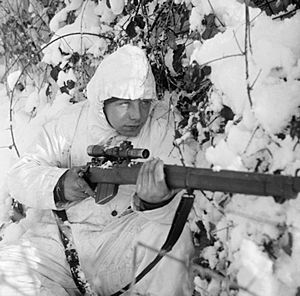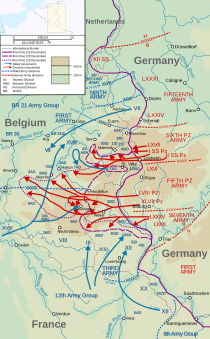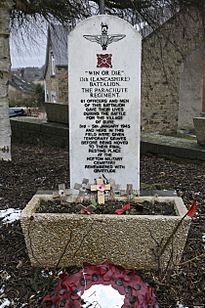Battle of Bure facts for kids
Quick facts for kids Battle of Bure |
|||||||
|---|---|---|---|---|---|---|---|
| Part of Battle of the Bulge | |||||||
 British Airborne Sniper in snow camouflage with Lee–Enfield rifle in the Ardennes, 14 January 1945 |
|||||||
|
|||||||
| Belligerents | |||||||
| Commanders and leaders | |||||||
| Units involved | |||||||
| Casualties and losses | |||||||
| Roughly 250 combined killed and/or wounded 16 tanks damaged or destroyed |
Roughly 500 killed and/or wounded 11 tanks damaged or destroyed |
||||||
The Battle of Bure was a fierce fight during the Battle of the Bulge. This battle happened from January 3 to 5, 1945. It was in the final months of the Second World War. The Allies launched a counterattack to push back German forces. They wanted to clear the area known as the 'Bulge'.
The British XXX Corps led this effort. They had the British 6th Airborne Division with them. Their job was to clear areas east of Dinant, Rochefort, Grupont, and Bure in Belgium. Bure was taken after three days of hard fighting. Grupont and Rochefort were cleared more easily. The Allied advance then continued.
Contents
The Ardennes Offensive: Why the Battle of Bure Happened
In December 1944, the German army started a huge surprise attack. This attack went through the forests of the Ardennes. Their goal was to cross the Meuse river. Then they wanted to reach Antwerp. This would split the Allied armies and cut off their supplies.
The 6th Airborne Division was part of the First Allied Airborne Army. This group was a backup force for the Allies in Europe. Two other American airborne divisions were already in France. The 6th Airborne Division had been resting in England. They had fought well in Normandy. They were then sent by sea to Belgium. Their mission was to help defend against the German attack.
On Christmas Day, the 6th Airborne Division moved into position. They were placed in front of the main German advance. By Boxing Day, they were ready. They formed a defensive line between Dinant and Namur. This line was along the Meuse river. Soon after, the British XXX Corps stopped the furthest German push. The 6th Airborne Division then advanced. The 3rd Parachute Brigade was on the left. The 5th Parachute Brigade was on the right. The 6th Airlanding Brigade was held in reserve. By the time they arrived, the German attack had already slowed down.
The Battle for Bure: A Tough Fight
Just before New Year's Day, the brigades got new orders. They were told to advance against the German forces. On January 2, 1945, they had to capture Bure and Grupont. They had help from Sherman tanks. These tanks were from the Fife and Forfar Yeomanry. They were usually with the 11th Armoured Division. After taking these villages, they would secure a crossing over the Lomme river. This would stop any German breakthroughs. It would also put the Germans on the defensive.
The next day, the 13th (Lancashire) Parachute Battalion began their attack. They were part of the 5th Parachute Brigade. They left Resteigne on foot. At 1:00 PM, they started attacking Bure. 'A' Company was to secure the village. 'B' Company would take the high ground. 'C' Company was kept in reserve. They had tank support.
The attack immediately faced heavy fire. German mortars and machine guns fired at them. German tanks also supported the defense. Both companies started losing soldiers. They were pushed back at first. But they regrouped and attacked again. This time, 'A' Company got into the village. 'B' Company reached the high ground. From there, they could also enter Bure. At 5:00 PM, 'C' Company joined them. They helped 'A' and 'B' Companies hold half the village. They now had tank and artillery support.
The Germans started counterattacking. But the battalion formed a strong defense. They made strong points in all the buildings they held. They sent out patrols to fight. They also fought off four German counterattacks. One attack on 'A' Company was stopped only when they called artillery fire on their own positions. The fighting was very close. Paratroopers used their fighting knives to stay hidden. It was too dangerous to move wounded soldiers or bring in supplies.
On January 4, the battalion faced constant artillery fire. They also fought off five more German counterattacks. They used their PIAT weapons to knock out tanks. At one point, an ambulance reached Bure. A Sergeant and a padre got out. The ambulance stopped near a German Tiger tank. A German officer appeared. He spoke perfect English. He agreed that the wounded could be collected. But he said the ambulance could not return.
By now, Bure was mostly destroyed. But the Germans still held houses and ruins. They hid in cellars and underground tunnels. They fought and sniped until the end. Tiger tanks were still in the village. This made clearing the area very hard. In the evening, 'C' Company joined the 13th Parachute Battalion. They were from the 2nd Battalion, Oxfordshire and Buckinghamshire Light Infantry. They were reinforcements from the 6th Airlanding Brigade.
In the early hours of January 5, the battalion launched a strong attack. They managed to push most Germans out of the village. One Tiger tank remained. It was hit repeatedly by PIATs but stayed. By 9:00 PM, the last German position was cleared by 'A' Company. The village was finally secure. German resistance stopped. At the same time, the 7th (Light Infantry) Parachute Battalion captured Grupont. They met only light resistance. With these goals achieved, the battle ended.
Aftermath: The Cost of Victory
The fight for Bure and nearby villages was costly. The 13th (Lancashire) Parachute Battalion lost about one-third of its soldiers. Seven officers and 182 enlisted men were lost. Sixty-eight of them were killed. The 2nd Battalion, Ox and Bucks, lost one officer and 20 enlisted men. Seven of them were killed. The Fife and Forfar Yeomanry and 23rd Hussars also had many losses. They lost sixteen Sherman tanks. The Belgian SAS lost three men while helping in the attack on Bure.
The 13th (Lancashire) Parachute Battalion left Bure. Troops from the 29th Armoured Brigade replaced them. The 6th Airborne soldiers then helped free other towns. These included Wavreille, Jemelle, and Roy. On January 11, 1945, a patrol made a sad discovery. It was from the 1st Canadian Parachute Battalion. They found the bodies of 34 civilians. These people had been murdered by the Germans on Christmas Eve. This happened in Bande.
By January 6, the 6th Airborne Division moved to Holland. They patrolled along the Maas river. In late February, they returned to the United Kingdom. They prepared for their next mission, Operation Varsity. On January 16, 1945, the Allied armies joined up. General Courtney Hodges and General George S. Patton met. The Allies then launched a counter-offensive. They pushed towards the German border. They took back all the land the Germans had gained.
Legacy: Remembering the Battle
A memorial for the 13th Parachute Battalion stands in Bure. Inside the church, there is a memorial book. It honors the men of the 6th British Airborne Division. They were killed during the Ardennes campaign. There is also a Commonwealth War Graves Commission cemetery at Hotton.
The battle is also shown in the video game Call of Duty: World at War – Final Fronts.



